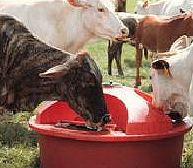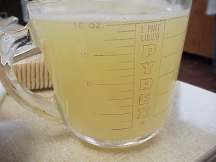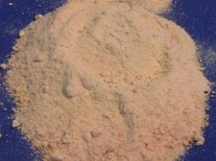|
|
 |
| Welcome | Getting Started | Resources | Site Map |
Week 2
High-Energy Feedstuffs |
Instructions for listening to audio clips
- Download the QuickTime Player to listen to the audio files.
- Read the QuickTime Instructions for installation help.
- Download the RealPlayer to listen to the audio files
- Instructions are on the RealPlayer download page
High-Carbohydrate Liquid Feeds
Time: 5.24
Follow along with the audio...
- Molasses
- Cane and beet molasses
- Primary
- By-products of sugar production
- Sources – sugarcane and sugar beets
- Similar nutritional value
- Lesser sources
- By-products of citrus fruit, starch, and wood production
- Citrus molasses
- Unpalatable
- Wood molasses
- Do not feed to nonruminants
- Liquid
- Thick, black solution
- Cost-effective energy source
- Dried
- Figure 5.5 – Dried molasses
- Not cost-effective
- Quality
- Dependent on sugar content
- Expressed as degrees Brix
- Table 5.1 – Minimum sugar and Brix requirements for cane, beet, citrus, and starch molasses
- Nutritional value
- Varies
- Good energy source
- High in sugars
- Low protein
- Good source of macro and microminerals
- Especially K, Ca, Cl, and sulfate salts
- Milling and feeding characteristics
- Aid in pelleting
- Reduce dust
- Carrier
- Example – molasses-urea blocks for ruminants
- Palatable
- Feeding livestock
- Rate
- Optimal - 10%
- For poultry, maximum 5%
- Inclusion
- Mixed
- Pellet
- Free-choice
- Blocks
- Feeder
- Figure 5.6 – Beef cattle consuming free-choice molasses

- Liquid milk by-products
- By-products of cheese production and/or products of whey
- Fresh, acid, condensed, and dehydrated (dried) whey
- Whey
- Figure 5.7 – Liquid whey
- Liquid portion remaining after cheese production
- Consists of majority of water, lactose, minerals, and water-soluble proteins of milk
- Liquid whey
- Low nutritional value
- Dry matter - 4-7%
- Condensed whey
- Higher nutritional value
- Dry matter at 40-50%
- Of the DM, 10-13% CP and 55-70% lactose
- Fed to cattle, pigs, and poultry
- Dehydrated whey
- Higher nutritional value
- Dry matter – greater than 90%
- Figure 5.8 – Dried whey
- Also fed to cattle, pigs, and poultry
- Cost
- Original cost
- Transportation cost
- Spoilage of liquid and condensed
- Products used similar to condensed whey
- Condensed whey solubles
- Condensed whey product
- Additional high-carbohydrate liquid feeds
- Condensed soybean solubles
- 6-7% CP
- 57% total soluble carbohydrates
- Liquefied corn product
- 8-9% CP
- Minimum 30% solids
- Lower carbohydrate liquid feeds
- Extracted streptomyces solubles, condensed molasses solubles, and citrus condensed molasses solubles

| Molasses
Type |
Minimum Sugars,
% |
Minimum Density,
Brix |
|---|---|---|
Cane |
43 |
79.5 |
Beet |
48 |
79.5 |
Citrus |
45 |
71 |
Starch |
50 |
73* |
*Total solids |
||


| |
| Welcome | Getting Started | Resources | SiteMap |